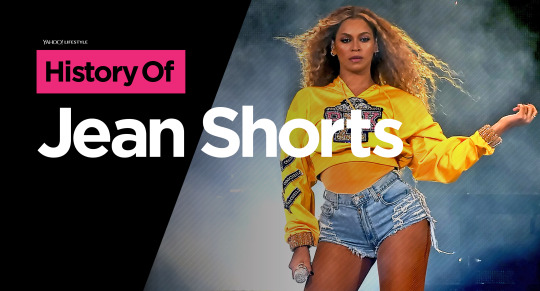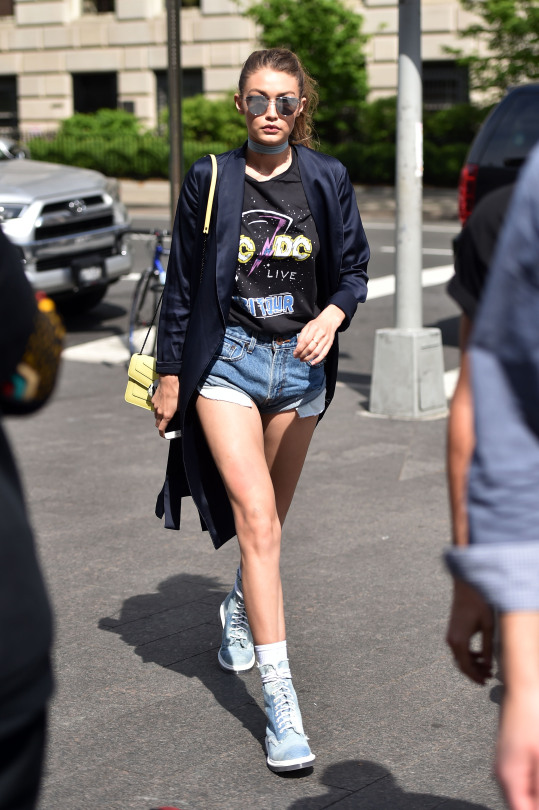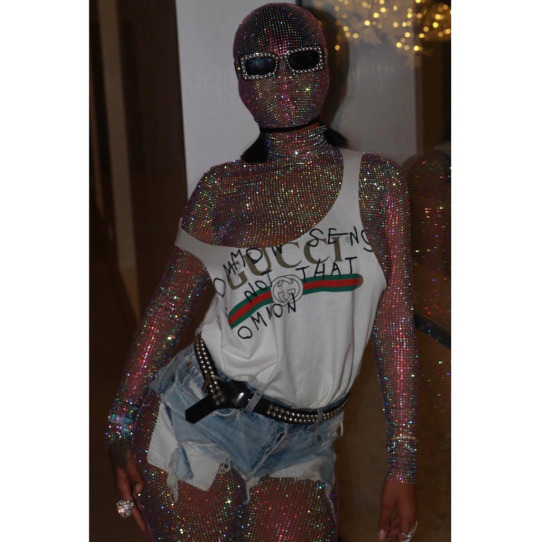#gered slays again!!!
Text
sparks photographed by gered mankowitz, 1977?-1980




NUMBER ONE BOYS EVER!!!
(The photographer says the top two are from 1977 but they look more No 1 in Heaven era to me… possibly even later than that but who can say)
#gered slays again!!!#my good pal Ron is looking weird as hell in the second two#we love a weird king#like the EYELINER in the 3rd one?? hello?? and his mouth is open in the last one crazyyy#sparks#ron mael#russell mael
32 notes
·
View notes
Text
See the evolution of summer's sexiest shorts from the 1940s to the 2000s

Few clothing items usher in summer quite like a perfectly worn-in, frayed, and ripped pair of denim shorts. Some call them jorts (aka jean shorts), while others might prefer “cutoffs.” They’re a 21st century festival staple and a street-style favorite, with price tags that span the gamut from a couple bucks for some vintage Levi’s dug up in a thrift store, to roughly $1K for this Valentino pair, embroidered with butterflies.
But, before there were jorts, there were jeans. It’s nearly impossible to imagine a world or closet without denim, yet the durable, universally beloved garment only dates back to late 19th century, when Levi Strauss (along with a tailor, Jacob Davis) invented “waist overalls” in 1873, named for where the style starts on the body, compared to the full-body overalls of the past.


From left to right: Students at Los Angeles City College in 1958, Karen Erickson, 19; John Zinda, 20; Annette Schiff, 19; Biggio Pennino, 21; and Al Ponce, 19, look on as Jerry Brooks, 18 (second from left), reads a campus order instructing students not to wear shorts. (Photo by USC Libraries/Corbis via Getty Images)
Shorts have been around since the early 20th century, remaining taboo through the 1930s, 1940s, and 1950s, for both men and women. There were even dress codes against, and fines for, wearing shorts, in certain cities throughout midcentury America.
Though it’s unclear when in the 20th century, exactly, the denim cutoff was born, denim itself was invented in the 1700s in Nîmes, France, and was initially touted as being completely tear-resistant. (The word “denim” actually refers to the birthplace of the sturdy fabric: it’s derived from serge de Nîmes in French, which translates as serge (a sturdy fabric) from Nîmes.


Punk rock singer and poet Patti Smith poses for a studio portrait. (Photo by Lynn Goldsmith/Corbis/VCG via Getty Images)
Long before jorts was a word — a dictionary-official one, even, but more on that later — the shorts style picked up popularity in the 1970s. The edgy twist on a beloved American staple was particularly big during the decade famous for punk and rock musicians. There’s a subtle but powerful symbolism in literally ripping apart a material that, while invented across the pond in France, had become strongly associated with American workmanship.
In the latter part of the decade, Patti Smith, a denim devotee in general, often donned pairs of roughly chopped and cuffed jean shorts, topped with oversized tweed mens’ blazers, loose T-shirts, or baggy button-downs. Smith often sported her cutoffs with black tights underneath, and wore them in a slew of situations, often photographed with her partner Robert Mapplethorpe, as well as onstage while performing.

Debbie Harry of Blondie on the beach at Coney Island (Photo by Roberta Bayley/Redferns)
Another musical icon to memorably rock the rebellious style was Debbie Harry: The Blondie frontwoman donned a very short, very ripped pair of cutoffs while cavorting on the beach in Coney Island, Brooklyn, in a series of shots from 1977 by rock photographer Roberta Bayley.


Daisy Duke, played by Catherine Bach in “The Dukes of Hazzard.” (Photo: Everett Collection)
The garment was most powerfully immortalized by actress Catherine Bach in the TV series The Dukes of Hazzard, which aired from 1979 to 1985. Bach’s character, Daisy Duke, frequently flaunted her gams in extra-short cutoffs to help her get out of perilous situations that she and her two brothers found themselves in. The hot-weather answer to denim wearing become synonymous with a stereotypical, Southern flirtatious sex appeal, thanks to the show, and bequeathed them an enduring nickname: The shorts are (still!) often called “Daisy Dukes.”
However, despite their breezy, bare-legged appearance, the cutoffs featured on The Dukes of Hazzard weren’t exactly styled in the most beach-friendly manner. The show’s network, CBS, deemed the minuscule shorts inappropriate for TV, and Bach had to wear flesh-hued tights under her cutoffs in every scene.


Behind the scenes on “Stunt Women”: Cindy Crawford in 1992 (Photo: Shutterstock)
Cutoffs got the Vogue treatment in the early 1990s. Supermodel Cindy Crawford wore a pair as part of a photoshoot on a Malibu beach in 1992, Herb Ritts shot Cindy Crawford for the November issue of Vogue, cavorting on the beach in Malibu with her husband at the time, Richard Gere, her supermodel physique displayed nicely in a pair of frayed Levi shorts. Before cutoffs made a Vogue cameo, their full-length predecessors were notably featured on the fashion bible’s cover four years before, when the magazine’s then newly minted editor-in-chief, Anna Wintour, featured a pair of blues on her very first cover, in 1988.
A big part of the charm of cutoffs is how democratizing and DIY-friendly they are; crafted for a couple bucks, or free, even, using any old pair of jeans and a sharp pair of scissors. The advent and popularity of the premium denim market in the late ‘90s and early aughts ushered in previously unheard-of triple-digit prices for the wardrobe workhouse, from brands like Frankie B, Seven for All Mankind, Paper Denim & Cloth, and True Religion. Shorts versions of pricy premium denim also took off, whether intentionally sold with abbreviated hemlines or in DIY form.


A model on the runway at the Spring/Summer 2000 Chloé ready-to-wear collection designed by Stella McCartney, wearing white tube top with smocking at top edge, fringed hot pants, high-heel sandals with white and gold ankle bands, and carrying a straw bag with cat-face design. (Photo: Getty Images)
But the humble cutoff has also gotten more upscale runway treatments: In 1999, for one of Stella McCartney’s final collections as creative director of Chloé, she showed ultrashort white shorts with a low rise (as was the preferred, hipbone-exposing silhouette of the era) and extra-distressed hems.
Then, the shorts reconnected with their musician-vetted roots in a new way, thanks to their growing ubiquity with festival fashion. Specifically, with one increasingly popular festival: Coachella. The annual three-day blowout in the desert of Indio, Calif., which began in 1999, is where many a trend has hit critical mass in the 21st century, particularly in the past five to 10 years, be it jorts, flower crowns, or chokers.


Jessica Simpson in the film version of “The Dukes of Hazzard.” (Photo: Everett Collection)
In 2005, Jessica Simpson introduced Daisy Duke (both the character and her signature shorts) to a younger generation with the film version of The Dukes of Hazzard. Unlike the O.G. Daisy Duke, Simpson didn’t wear tights under her cutoffs. Plus, the entire ensemble (both the shorts’ length and fit, and the snugness and cleavage-baring factor of her tops) were sexed up in the modernized, silver-screen take on the campy TV series.


Kendall Jenner in 2016, wearing a fringe jacket, jean shorts, and velvet boots. (Photo: Getty Images)
In 2015, the term “jorts” became a legitimate, official noun: the term, a portmanteau of “jeans” and “shorts,” was added to the Oxford dictionary that year, along with other modern vernacular, like selfie, twerk, and guac.
In the past decade, denim cutoffs have yet again cropped up on runways, in their fanciest, priciest form fathomable. During designer Hedi Slimane’s stint as creative director at Saint Laurent from 2012 to 2016, one of the (many) sweeping tweaks he made to the venerable French fashion house was peppering his collections with supershort hemlines and punky vibes, sometimes translating to cutoff shorts (and even cutoff denim overalls, like this spring 2016 Saint Laurent look).

Alexander Wang Spring-Summer Collection 2016 at New York Fashion Week (Photo: Getty Images)
Alexander Wang trotted out some artfully beat-up, ultrashort pairs in his fall 2016 collection, too. 2016 also marked the year supermodels Kendall Jenner and Gigi Hadid added jorts to their model-off-duty street style.

Gigi Hadid in 2016 wearing jean shorts, a T-shirt, and navy coat. (Photo: Getty Images)


Beyoncé wears the Saint Laurent sparkle boots alongside Jay-Z. (Photo: Instagram)
The most epic jorts moment in recent memory came courtesy of the one and only Beyoncé, at what’s become the most important modern natural habitat for the garment: Coachella. While headlining the festival in April 2018, Queen Bey slayed in her first of five outfit changes throughout her set: a heavily shredded, customized pair of Levi’s High-Rise shorts, paired with a bejeweled yellow satin hoodie, flesh-toned fishnets, and iridescent sequined boots. The superstar had another memorable cutoffs getup a couple months earlier, in December 2017, thanks to a pair of black cutoffs paired with glittery Saint Laurent knee-high boots.


Beyoncé at this year’s Coachella Valley Music and Arts Festival in April in Indio, Calif. (Photo: Getty Images)
These days, denim cutoffs are less associated with their late 20th century connotations of Daisy Duke and punky DGAF rock legend style, and more with celebrity street style (and, of course, festival garb).
A plethora of stars regularly don cutoffs, both off-duty and, occasionally, on the red carpet. To wit: famous fans of jorts include Kate Moss, Taylor Swift, Kim Kardashian, Victoria Beckham, Gigi Hadid, Rihanna (in another epic Coachella getup, pairing jorts with a Gucci bejeweled bodysuit and matching balaclava), and longtime cutoffs connoisseur, Chloë Sevigny.
So, just like the enduring, universal appeal of jeans — despite changing silhouettes, rises, and inseam lengths that cycle in and out of trendiness over the years — denim cutoffs are the indispensable warm-weather counterpart.

Rihanna wears a Gucci sparkle bodysuit and balaclava with her jorts at Coachella. (Photo: Instagram)
The appeal varies widely: For some, there’s a sort of Southern sexpot vibe, thanks to the surprisingly sartorially memorable television character, Daisy Duke, while others might associate with it a punk-rock insouciance, à la Patti Smith. Or, perhaps, a carefully curated but “carefree” quintessential Coachella look.
Expect this wardrobe staple to stick around for many more decades, sure to be championed by a new generation of style icons, across music genres and various creative fields, personal style preferences, and price points. In other words, love them or loathe them, in all likelihood, jorts are here to stay.
Read More from Yahoo Lifestyle:
• See the evolution of the prom dress from the 1940s to the 2000s
• Olympian Adam Rippon on coming out before a major skating competition: ‘I felt power going out there’
• Innovative, resilient, woke: Ready or not, Generation Z has arrived
Follow us on Instagram, Facebook, and Twitter for nonstop inspiration delivered fresh to your feed, every day.
yahoo
#_revsp:wp.yahoo.style.us#jean shorts#The history of#jorts#_uuid:bce9fa5d-d942-3b5f-a503-e8d43b99779a#style#history#beyonce#summer#_author:Alexandra Ilyashov#_lmsid:a0Vd000000AE7lXEAT#fashion
4 notes
·
View notes
Text
WIGLAF his name was, Weohstan's son,
linden-thane loved, the lord of Scylfings,
Aelfhere's kinsman. His king he now saw
with heat under helmet hard oppressed.
He minded the prizes his prince had given him,
wealthy seat of the Waegmunding line,
and folk-rights that his father owned
Not long he lingered. The linden yellow,
his shield, he seized; the old sword he drew: --
as heirloom of Eanmund earth-dwellers knew it,
who was slain by the sword-edge, son of Ohtere,
friendless exile, erst in fray
killed by Weohstan, who won for his kin
brown-bright helmet, breastplate ringed,
old sword of Eotens, Onela's gift,
weeds of war of the warrior-thane,
battle-gear brave: though a brother's child
had been felled, the feud was unfelt by Onela.[1]
For winters this war-gear Weohstan kept,
breastplate and board, till his bairn had grown
earlship to earn as the old sire did:
then he gave him, mid Geats, the gear of battle,
portion huge, when he passed from life,
fared aged forth. For the first time now
with his leader-lord the liegeman young
was bidden to share the shock of battle.
Neither softened his soul, nor the sire's bequest
weakened in war.[2] So the worm found out
when once in fight the foes had met!
Wiglaf spake, -- and his words were sage;
sad in spirit, he said to his comrades: --
"I remember the time, when mead we took,
what promise we made to this prince of ours
in the banquet-hall, to our breaker-of-rings,
for gear of combat to give him requital,
for hard-sword and helmet, if hap should bring
stress of this sort! Himself who chose us
from all his army to aid him now,
urged us to glory, and gave these treasures,
because he counted us keen with the spear
and hardy 'neath helm, though this hero-work
our leader hoped unhelped and alone
to finish for us, -- folk-defender
who hath got him glory greater than all men
for daring deeds! Now the day is come
that our noble master has need of the might
of warriors stout. Let us stride along
the hero to help while the heat is about him
glowing and grim! For God is my witness
I am far more fain the fire should seize
along with my lord these limbs of mine![3]
Unsuiting it seems our shields to bear
homeward hence, save here we essay
to fell the foe and defend the life
of the Weders' lord. I wot 'twere shame
on the law of our land if alone the king
out of Geatish warriors woe endured
and sank in the struggle! My sword and helmet,
breastplate and board, for us both shall serve!"
Through slaughter-reek strode he to succor his chieftain,
his battle-helm bore, and brief words spake: --
"Beowulf dearest, do all bravely,
as in youthful days of yore thou vowedst
that while life should last thou wouldst let no wise
thy glory droop! Now, great in deeds,
atheling steadfast, with all thy strength
shield thy life! I will stand to help thee."
At the words the worm came once again,
murderous monster mad with rage,
with fire-billows flaming, its foes to seek,
the hated men. In heat-waves burned
that board[4] to the boss, and the breastplate failed
to shelter at all the spear-thane young.
Yet quickly under his kinsman's shield
went eager the earl, since his own was now
all burned by the blaze. The bold king again
had mind of his glory: with might his glaive
was driven into the dragon's head, --
blow nerved by hate. But Naegling[5] was shivered,
broken in battle was Beowulf's sword,
old and gray. 'Twas granted him not
that ever the edge of iron at all
could help him at strife: too strong was his hand,
so the tale is told, and he tried too far
with strength of stroke all swords he wielded,
though sturdy their steel: they steaded him nought.
Then for the third time thought on its feud
that folk-destroyer, fire-dread dragon,
and rushed on the hero, where room allowed,
battle-grim, burning; its bitter teeth
closed on his neck, and covered him
with waves of blood from his breast that welled.
[1] That is, although Eanmund was brother's son to Onela, the slaying of the former by Weohstan is not felt as cause of feud, and is rewarded by gift of the slain man's weapons. [2] Both Wiglaf and the sword did their duty. -- The following is one of the classic passages for illustrating the comitatus as the most conspicuous Germanic institution, and its underlying sense of duty, based partly on the idea of loyalty and partly on the practical basis of benefits received and repaid. [3] Sc. "than to bide safely here," -- a common figure of incomplete comparison. [4] Wiglaf's wooden shield. [5] Gering would translate "kinsman of the nail," as both are made of iron.
0 notes